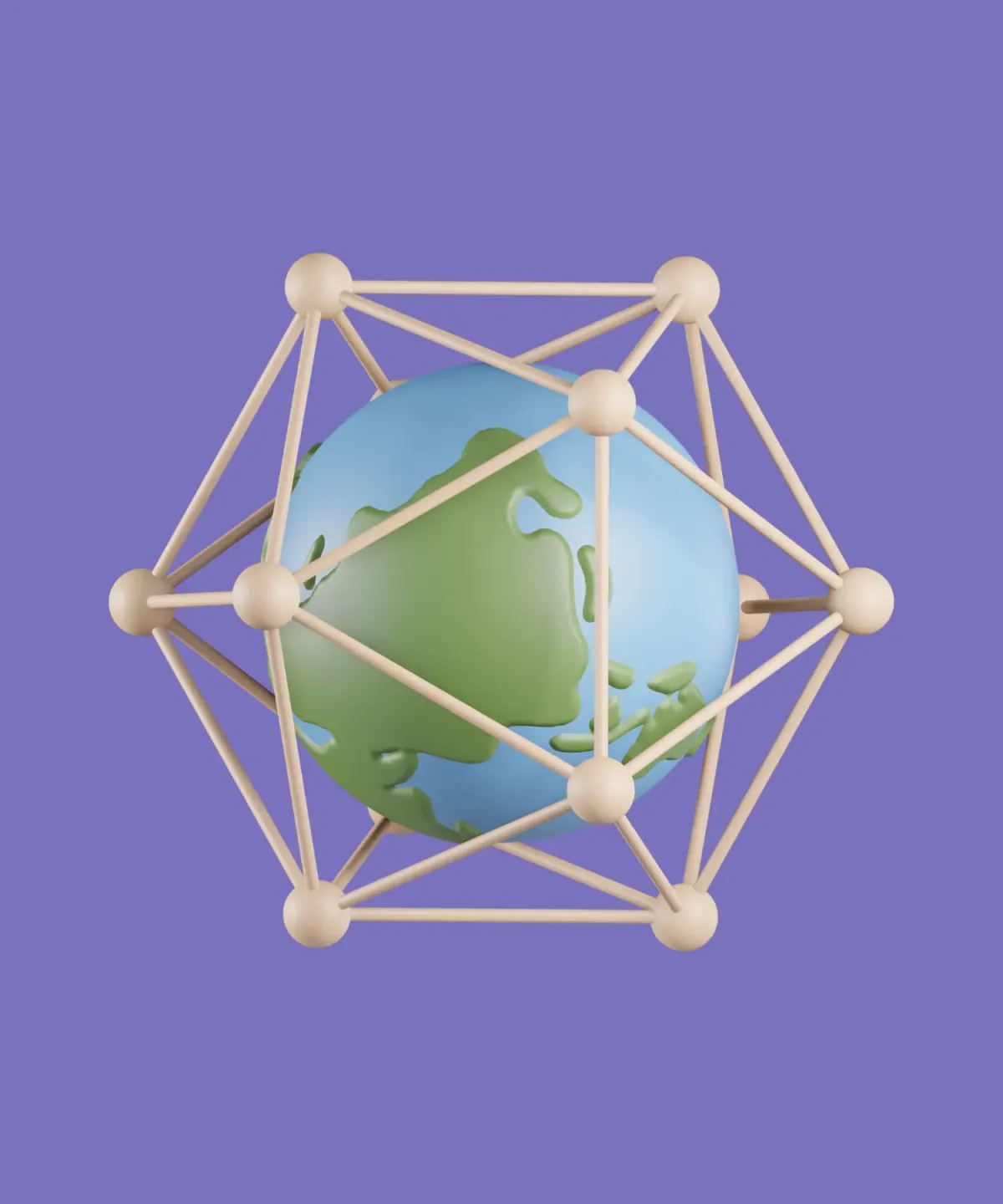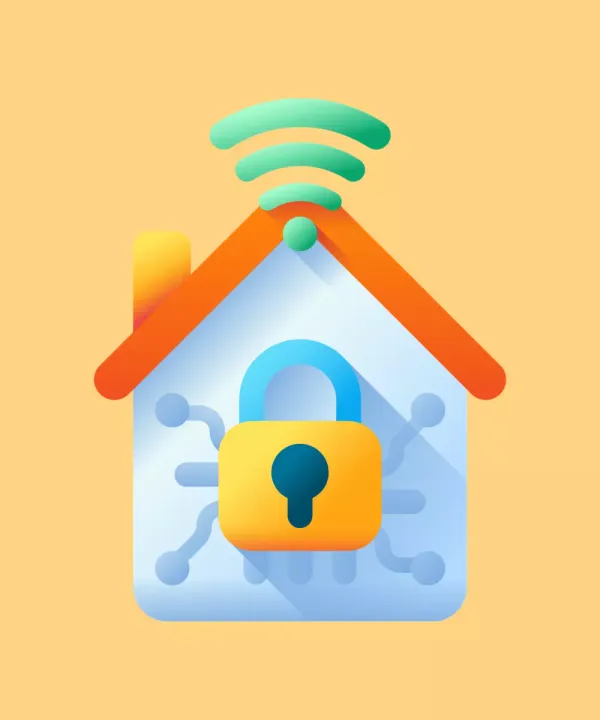The Internet of Things (IoT) has become an essential part of modern life. With the help of interconnected devices and sensors, users can take advantage of the latest technology to improve their homes, lives, and businesses' efficiency.
Based on the available data provided by IoT-analytics, it is estimated that the global count of interconnected devices currently stands at approximately 20 billion. This connectivity contributes to an industry valued at roughly $150 billion. Projections indicate that by 2030, the number of active IoT devices will rise to over 30 billion, potentially elevating the industry's value to $1 trillion.
Below is a chart of the top segments where IoT is expected to be used by 2025.
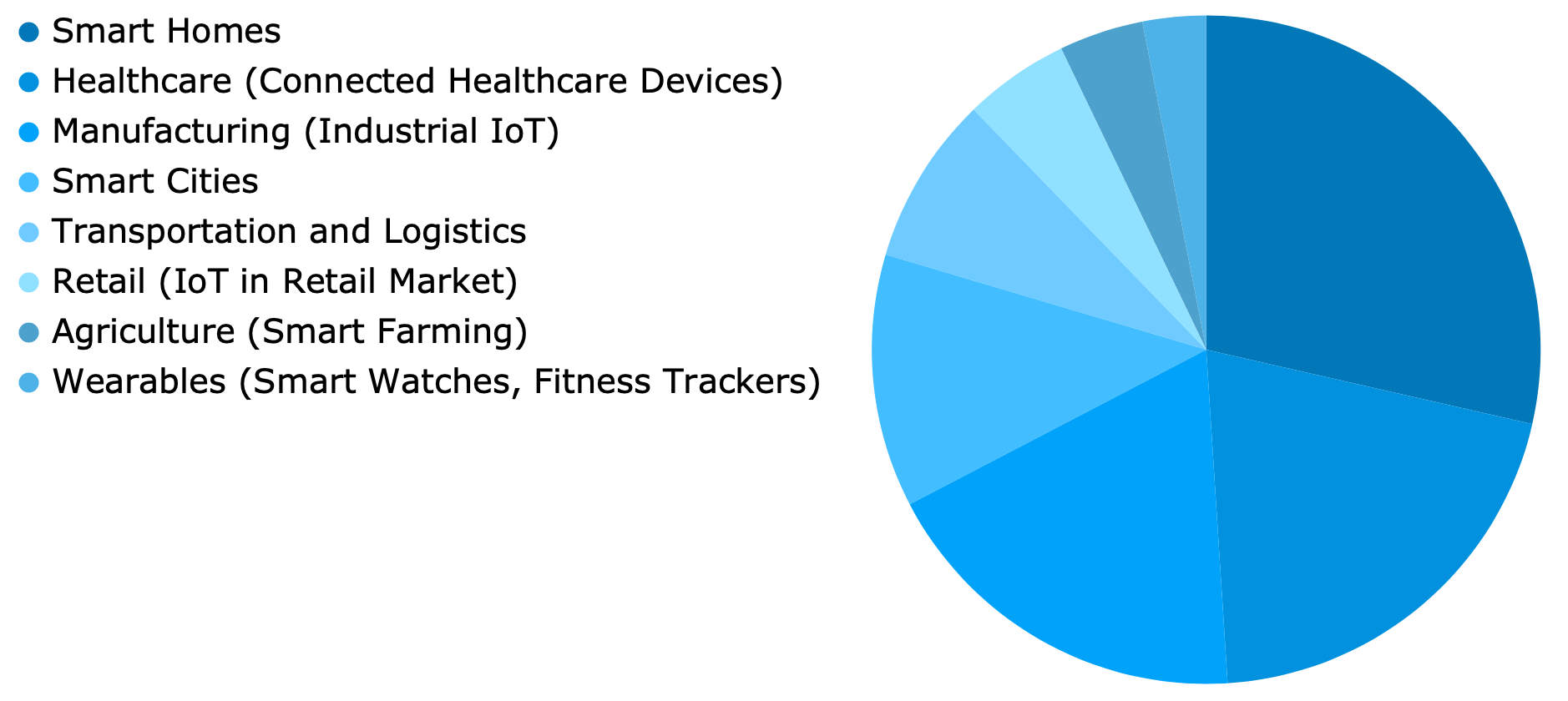
IoT Architectures: Overview
One of the earliest and most straightforward IoT architectures is Three-layer Architecture. This includes the following layers:
Perception Layer (or Edge Layer): This is the layer where all the "action" starts. Devices, like sensors (that might detect temperature or light) and actuators (devices that perform actions, like turning on a light), are found here. These devices pick up information from their surroundings and then send it onward.
Network Layer: Responsible for transmitting the data collected by the perception layer. It involves all the necessary protocols and infrastructures such as gateways, routers, the cloud, and more to ensure data moves reliably from devices to servers and back.
Application Layer: This is where the user interacts with the IoT system. Based on the processed data from the devices, this layer provides services like data analytics, device management, and user interfaces.

Various advancements in IoT architecture have introduced different approaches. The Five-layer Architecture and Service-oriented Architecture (SOA) enhance clarity and modularity. Meanwhile, Cloud-based Architecture utilizes cloud servers for scalability, and Fog/Edge Computing Architecture offers local data processing for quicker responses. The choice of architecture depends on project scale, response needs, data volume, and factors like security and flexibility.
Perception Layer
The Perception Layer, often termed the Edge Layer in IoT, primarily uses sensors and actuators. Sensors are devices that detect and measure changes in the environment, like temperature or humidity, and convert them into data. Actuators, on the other hand, are devices that perform an action based on the received data, such as turning on a fan when a room gets hot. In essence, while sensors gather information from the environment, actuators take actions based on that information, making real-time interactions possible in the IoT ecosystem.
When selecting IoT devices for deployment, several critical factors come to the fore:
- The security features of a device are paramount to ensure protection against potential cyber threats.
- Power efficiency is crucial, especially for devices expected to operate for extended periods without frequent recharging.
- Device interoperability can't be overlooked, as seamless integration with existing systems is essential.
- Cost-effectiveness plays a significant role, balancing between functionality and budgetary constraints.
Network Layer
Network layer acts as the transportation hub for data, ferrying information from the frontline Perception Layer to the processing centers and then back again. The core components here are various communication protocols and connectivity options, ranging from traditional Wi-Fi and Ethernet to specialized ones like Zigbee.
The choice of protocol often hinges on factors like range, data volume, power efficiency, and scalability.
For communications within a local network, such as homes or office spaces, the primary focus is on immediate, short-range interactions. Transitioning to broader scopes, we find devices that need to communicate over the internet. These scenarios demand reliable, secure, and often lightweight protocols to ensure data can traverse vast distances efficiently.
Wireless protocols: overview
IoT protocols lay the foundation for seamless communication between devices and applications. Below are some of the more common ones:
- Bluetooth/BLE: Bluetooth and Bluetooth Low Energy (BLE) are common local communication methods. For example, an app can connect to a Bluetooth-enabled thermostat to monitor and control the room temperature. These protocols are quintessential for gadgets like smartwatches or fitness bands that sync with mobile devices.
- Wi-Fi with MQTT or HTTP: If the devices are connected to the same local network, Wi-Fi can be used for communication, typically with protocols like MQTT or HTTP. Although this communication happens through the local network, these protocols can also work over the internet. Wi-Fi is predominant, catering to smart home devices like thermostats, cameras, or even smart refrigerators that can be controlled via an app.
- Zigbee & Other Protocols: Other protocols like Zigbee or Z-Wave, often used in smart home setups, could also be employed for local communications. Zigbee often emerges as the preferred choice in more interconnected home environments, enabling a mesh of devices — from lights to security systems — to communicate with each other.
Bluetooth/BLE
Bluetooth is a wireless technology standard used for exchanging data between fixed and mobile devices over short distances. It uses UHF radio waves in the ISM band from 2.4 to 2.485 GHz.
Bluetooth creates a network known as a piconet, which is an ad hoc computer network of devices using Bluetooth technology protocols. These networks are established dynamically and automatically as Bluetooth devices enter and leave radio proximity.
If two Bluetooth devices want to connect, one of them sends out an inquiry request, and the other sends back an inquiry response. Once they have recognized each other, they connect. One device acts as the master (central device), and the others act as slaves (peripheral devices). For the devices to communicate, they need to pair up using a shared secret, known as a link key. If they've never paired before, they will do so through a process known as bonding.
There are two primary types of Bluetooth devices:
1. Bluetooth Classic (BR/EDR): This variant is the one we often encounter in wireless speakers, car infotainment systems, and headphones. Designed for continuous data streaming, it's ideal for devices that need to transmit large volumes of data steadily.
2. Bluetooth Low Energy (BLE): Introduced in Bluetooth's 4.0 version, BLE is the go-to for applications where power consumption needs to be kept minimal. It's often found in battery-powered devices or those that send small chunks of data with large intervals in between, like environmental sensors or wireless switches.
In many Internet of Things (IoT) devices that utilize small sensors and gadgets, BLE has become the most commonly used communication protocol, surpassing Bluetooth Classic. In December 2016, the Bluetooth Special Interest Group (SIG) introduced Bluetooth 5.0, with most of its enhancements focused on BLE rather than Bluetooth Classic.
To better understand how the BLE protocol works, let's look at its generalized architecture.

Imagine BLE as a language with its own set of rules.
GATT (Generic Attribute Profile) is like the grammar of BLE language. It defines the structure for data organization and how devices exchange data. GATT operates using 'services' and 'characteristics' – think of services as folders, and characteristics as files within these folders. Every 'service' and 'characteristic' in GATT has a UUID (Universally Unique Identifier), akin to a unique name.
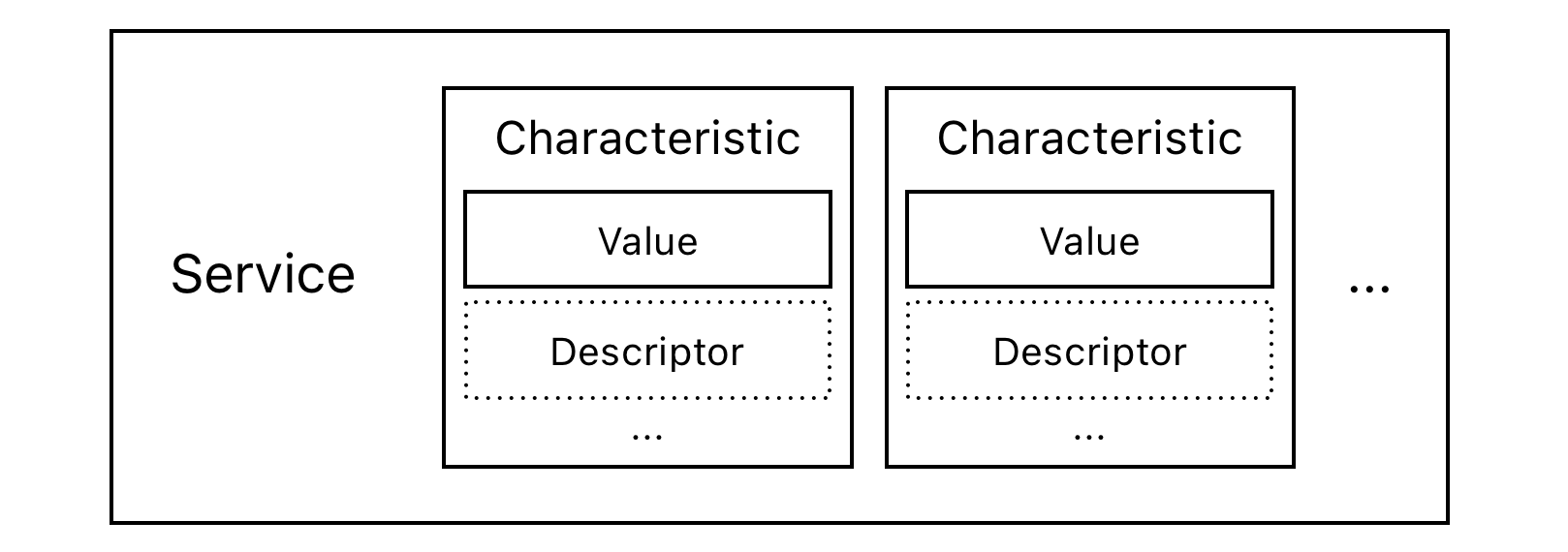
GAP (Generic Access Profile) is the rule-set for how BLE devices make themselves visible to the outside world and how they can interact with each other. It determines roles like which device broadcasts data and which one listens.
The Bluetooth mesh, introduced in July 2017, expands the range and applicability of Bluetooth networks, especially for industrial Bluetooth LE use. Traditional Bluetooth had two modes: one-to-one connections and one-to-many broadcasts. The mesh topology added a many-to-many configuration, allowing numerous devices to communicate within a network through mesh nodes. This facilitates vast device networks, making it ideal for extensive IoT applications.
MQTT & HTTP
A communication protocol called MQTT (Message Queuing Telemetry Transport) is used to send messages between devices in distributed systems that run on many platforms. It functions on the application layer and relies on TCP/IP for connecting and transferring data.
MQTT was created to simplify message exchange between servers and other devices and devices with constrained resources, such as sensors, microcontroller devices, or mobile devices. One of the most widely utilized communication protocols in the Internet of Things nowadays is MQTT.
MQTT operates on a "publisher-subscriber" model, different from traditional direct network interactions. Instead of direct interactions, a message broker manages the communication. This broker receives messages from the publishers and routes them to the appropriate subscribers.
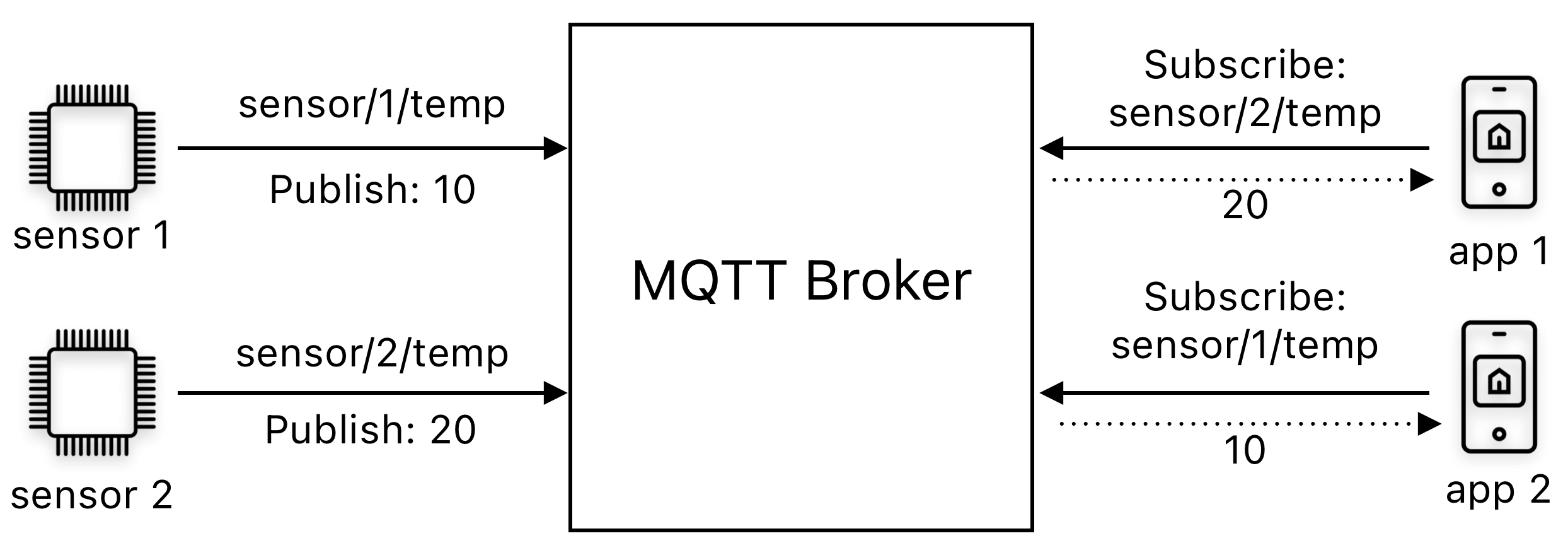
MQTT is a preferred choice for IoT data transmission due to its lightweight, scalable, and efficient nature. It's great for smart homes, letting lights, locks, and thermostats work together. It's also used in industries for tracking equipment or monitoring farm crops.
HTTP, initially designed for web transfers, is widely recognized and optimal for IoT applications that align with web services or pre-existing infrastructures. It's text-based, human-readable, and suits occasional data exchanges. Conversely, MQTT, tailored for IoT, prioritizes low overhead and persistent bi-directional communication. While MQTT offers features like message queuing, HTTP is better for direct web platform integrations. The selection hinges on the IoT project's distinct needs.
Zigbee
Zigbee, named after the zig-zag patterns of bees, is a wireless protocol designed specifically for short-range, low-power device communication in IoT. Unlike Wi-Fi, which is more suited for high-bandwidth, long-range applications, Zigbee prioritizes energy efficiency and creates a mesh network, allowing devices to interconnect.
Use Cases:
- Home Automation: Zigbee is popular in smart home systems controlling lights, thermostats, and more.
- Industrial Settings: It's used in factories for monitoring and equipment control.
- Energy Management: Zigbee simplifies real-time energy monitoring in grids and households.
Advantages of Zigbee:
- Energy Efficient: Ideal for battery-powered devices.
- Mesh Network: Offers resilience; if one device fails, data finds another route.
- Secure: Features built-in encryption for data protection.
For integration with other platforms, the Zigbee2MQTT gateway translates Zigbee communication into MQTT. Zigbee2MQTT is a free and open-source software that allows you to turn Zigbee-based devices into MQTT-controlled devices. The software runs on a single-board computer like Raspberry Pi (or similar) and enables you to control and manage devices connected via Zigbee protocol with MQTT brokers. A tutorial on getting started can be found at the link.
When compared to Wi-Fi, Zigbee has a shorter range and less bandwidth but is more energy-efficient. It's optimal for applications where frequent communication and extended battery life are more critical than high-speed data transfer.
Application Layer
The application layer in IoT stands as the interface between the user and the intricate world of IoT. It provides the platform for the deployment of applications, managing and interpreting data, and ensuring smooth interaction between users and the interconnected devices.
Examples of real IoT applications:
- Google Home: A centralized home automation platform that controls smart devices, plays music, and answers questions using the Google Assistant.
- Latch: A system offering integrated building and apartment access through smart devices, enabling users to open, manage, and share the spaces they need through a single app.
- John Deere's MyOperations: An agricultural solution that allows farmers to monitor and control their machinery remotely, providing insights into crop health and machinery performance.
Steps to implement an IoT application:
- Requirement Analysis: Begin by identifying the specific needs and goals of the application.
- Data Collection: Use sensors or devices to gather the necessary data.
- Data Processing: Process the data to derive meaningful insights.
- Application Design & Development: Develop both the front-end (user interface) and the backend processes, ensuring alignment with user needs.
- Integration & Testing: Integrate with any necessary systems and test for functionality and security.
- Deployment: Deploy the application for the end-users.
Pitfalls in the development of such applications:
- Security Concerns: IoT devices often become targets due to the wealth of data they hold.
- Interoperability Issues: Ensuring different devices and systems work in harmony is challenging.
- Scalability: The application must be able to grow and manage an increasing number of devices.
- Latency: For real-time applications, even the smallest delay can hinder functionality.
Flutter in IoT
Flutter, Google’s open-source UI toolkit for mobile app development, has become a developer-favourite for creating beautifully designed and highly performant mobile applications. Thanks to Flutter's versatility and flexibility, developers can now seamlessly integrate IoT technology into their mobile applications.
In the fast-evolving IoT landscape, Flutter stands out as a robust framework, particularly noted for its adaptability to various communication protocols. Here's a list of some notable plugins:
- flutter_blue is a plugin for interacting with Bluetooth Low Energy (BLE) devices;
- flutter_reactive_ble offers a reactive approach to managing Bluetooth Low Energy in Flutter;
- quick_blue simplifies Bluetooth interactions in Flutter for quick results;
- nordic_nrf_mesh is a preferred choice for complex device network using the Mesh protocol;
- mqtt_client enables smooth MQTT protocol integration in Flutter for real-time data exchange.
When considering Flutter for IoT projects, especially in areas like home automation app development, its multifaceted plugin ecosystem proves invaluable. For those seeking guidance on choosing the right partners in this journey, insights on Flutter for mobile app development can be a helpful resource.
In essence, the IoT application layer serves as the user's gateway to the expansive IoT universe. Leveraging the right tools, staying vigilant of potential pitfalls, and aligning with evolving technologies are vital for successful application deployment.
Conclusion
The surge in IoT's popularity has reshaped the modern technological landscape, integrating smart devices into daily lives. IoT architectures, evolving from basic three-layer structures to cloud and edge models, are pivotal in determining device communication and data processing.
Central to this is the Perception Layer, which focuses on data collection through sensors and actuators. This data is then transmitted through the Network Layer, which relies on varied communication protocols, each tailored to specific needs. Among these, protocols like Bluetooth for short-range and MQTT for lightweight IoT communication are vital.
The Application Layer bridges users to this network, emphasizing seamless interaction and user experience. As the digital landscape changes, platforms like Flutter stand out for IoT mobile app development, offering a blend of performance, aesthetic appeal, and efficient device interaction.


